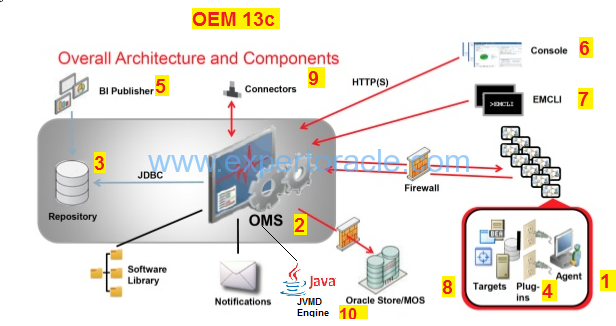Oracle Enterprise Manager is Oracle’s solution to manage/monitor various database/applications which may be running on Cloud infrastructure or on-premise. OEM 13c is the latest version at the time of writing this post. In this post we will discuss about the architectural components which are required by Oracle Enterprise Manager.
Below is simple architectural representations of an OEM 13c setup.

All the required architectural components are marked with numbers and are described below:
1) AGENTS
Agent or management agent is a piece of software that runs on every host that you want to monitor. Management agent work in conjunction with plug-ins to monitor the target server. All hosts where you install the agents are then termed as “Managed Hosts”.
Agents can be of two types:
CENTRAL AGENT : When you first install Oracle Management Service (OMS), by default you receive a Management Agent called the Central Agent. It is used for monitoring the OMS host, the OMS, and the other targets running on this OMS.
host.
STANDALONE TARGET AGENT : To monitor other hosts and the targets running on those hosts, you must install a separate Standalone Management Agent on each of those hosts.
2) ORACLE MANAGEMENT SERVICE
OMS is the actual brain of OEM. OMS is deployed over Weblogic 13c. It is a web-based application and perform below broad level activities:
- Works with the Management Agents and the plug-ins to discover targets.
- Monitor and manage the agents
- Store the collected information in a repository for future reference and analysis
- Renders the user interface for Enterprise Manager Cloud Control.
3) ORACLE MANAGEMENT REPOSITORY
Oracle Management Repository is simply a database/database schema where all the information collected by the Management Agent gets stored. The Management Repository then organizes the data so that it can be retrieved by the OMS and displayed in the Enterprise Manager Cloud Control console.
4) PLUG-INS
Plug-ins as name suggest are pluggable entities that offer special management capabilities customized to suit specific target types. Example if your target type is Oracle EBS, you will need specific plug-ins to monitor the Oracle EBS. Plug-ins are deployed to the OMS as well as the Management Agent in OEM 13c.
Good thing about Plug-ins is that they have independent release cycles, so every time you have a new version of an Oracle product released, you will have a new version of the plug-in released to support monitoring of that new product version in Enterprise Manager Cloud Control.
Default Plugins that OEM 13c will install are:
- Oracle Database
- Oracle Fusion Middleware
- Oracle Exadata
- Oracle Cloud Framework
- Oracle System Infrastructure
In addition to these plug-ins, you can optionally install other plug-ins available in the software kit.
5) BI PUBLISHER
Oracle Business Intelligence (BI) Publisher is Oracle’s primary reporting tool for authoring, managing, and delivering all your highly formatted documents. Starting with Oracle Enterprise Manager 13c, Oracle BI Publisher is installed and configured by default on the OMS.
6) CONSOLE
Console is the GUI Front end of the OEM application. With the help of the console, you can monitor and administer your entire computing environment from one location. All the systems and services including enterprise application systems, databases, hosts, middleware application servers, listeners etc will be visible through Console
7) EM CLI
The Enterprise Manager Command Line Interface (EM CLI) is a command-line too that is accessible through classic programming language constructs, enabling tasks t be created and run either from the command-line or programatically.
8) TARGETS
A target, or more specifically, a target instance, can be defined as any entity that can be monitored within an enterprise. Managed targets are the entities that Enterprise Manager can monitor and manage. Examples of targets include hosts, databases, application servers, applications, and listeners. As your environment changes, you can add and remove targets from Enterprise Manager as required.
9) CONNECTORS
Connector is a very specialized piece of software whose work is to be act like an intermediary between OEM and third party application like BMC Remedy Ticket generation system. Connectors make your life easier in the sense that they give you ready-made solution to connect your OEM system to other famous third party applications.
10) JVMD ENGINE
Java Virtual Machine Diagnostics (JVMD) Engine enables you to diagnose performance problems in Java applications. Starting with Oracle Enterprise Manager 13c , as part of the Oracle Fusion Middleware Plug-in deployment, one JVMD Engine is installed and configured by default on the
OMS. You will also need JVMD Agents to be manually deployed on the targeted JVMs.
- Oracle Multitenant DB 4 : Parameters/SGA/PGA management in CDB-PDB - July 18, 2021
- Oracle Multitenant DB 3 : Data Dictionary Architecture in CDB-PDB - March 20, 2021
- Oracle Multitenant DB 2 : Benefits of the Multitenant Architecture - March 19, 2021


Simple and straightforward explanation.
Thanks!!!